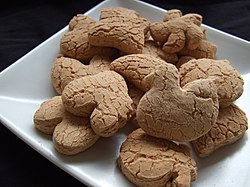 Kue bangkit, "rising" sago cookie | |
| Alternative names | Kuih bangkit |
|---|---|
| Type | Cookie |
| Course | Snack, dessert |
| Place of origin | Indonesia,[1][2] Malaysia[3][4][5] and Singapore[3] |
| Region or state | Southeast Asia (Brunei, Indonesia,[6][7] Malaysia and Singapore) |
| Main ingredients | Sago or tapioca starch, coconut milk, egg |
Kue bangkit is a small biscuit (kue or kuih) in Malay cuisine made from sago starch,[2] commonly found amongst the Malay communities in Brunei, Indonesia, Malaysia and Singapore.[1] This biscuit has various colours, ranging from white, yellowish to brown, depending on the additional ingredients.
In Indonesia, kue bangkit is associated with the Malay community of Riau[8] and Riau Islands provinces.[9][1][2] While in Brunei, Malaysia and Singapore, kuih bangkit is associated with both the Malay and Chinese communities.[10] It is one of the typical traditional cookies often consumed during Hari Raya and Chinese New Year.[3]
The biscuit is also consumed in other countries under different names; in Thailand (especially Southern Thailand), it is known as Khanom Ping while in Vietnam, these tapioca cookies are known as Banh Phuc Linh. These cookies are commonly served during the Lunar New Year in these countries.
- ^ a b c Arman, Dedi (3 January 2019). "Kue Bangkit, Cemilan dari Kundur". Kementerian Pendidikan dan Kebudayaan Republik Indonesia, Balai Pelestarian Nilai Budaya Kepulauan Riau (in Indonesian). Retrieved 2020-11-09.
- ^ a b c "Rahma: "Kue Melayu Harus Diekspos"". Lintas Kepri (in Indonesian). 9 September 2020. Retrieved 2020-11-09.
- ^ a b c "Origins: The Meaning Behind Chinese New Year Goodies From Around the World". MICHELIN Guide. Retrieved 2020-11-09.
- ^ Wu, David Y. H.; Tan, Chee Beng (2001). Changing Chinese Foodways in Asia. ISBN 9789622019140.
- ^ Ng, Chien Y.; Ab. Karim, Shahrim (June 2016). "Historical and contemporary perspectives of the Nyonya food culture in Malaysia". Journal of Ethnic Foods. 3 (2): 93–106. doi:10.1016/j.jef.2016.05.004.
- ^ "Kue Bangkit khas Riau Enak dan Anti Gagal - Resep". ResepKoki (in Indonesian). Retrieved 2020-06-08.
- ^ "Mengenal Resep Kue Bangkit yang Praktis dan Sedap". blueband.co.id (in Indonesian). Retrieved 2020-06-08.
- ^ Setyorini, Tantri (29 July 2020). "Resep Kue Bangkit Sagu Gula Aren". merdeka.com (in Indonesian). Retrieved 2020-11-09.
- ^ adminraya (18 October 2018). "Kue Bangkit, Jajanan Khas Kepulauan Riau". BatamRaya.com (in Indonesian). Retrieved 2020-11-09.
- ^ Cite error: The named reference
FM-Kuih Bangkitwas invoked but never defined (see the help page).